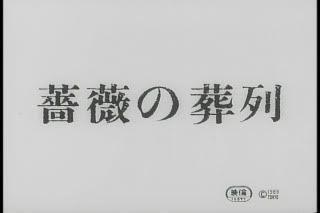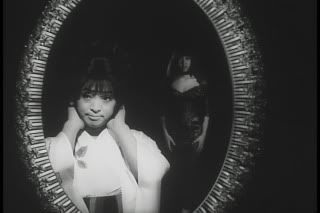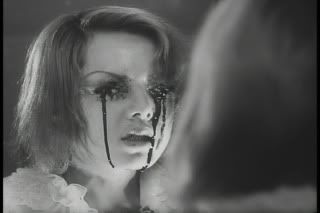
Man, the 60s were weird all over. Toshio Matsumoto’s Funeral Parade of Roses is a strange artifact of that wild decade, a bizarre experimental film which is part document of the youth counterculture, part a stylistic tale of the life of a drag queen, and part retelling of the Oedipus myth. Weird all over.

Funeral Parade follows Eddie, a drag queen (played by Peter, who later went on to star as the fool in Kurosawa’s Ran) who works as a hostess in a gay bar and who is having an affair with the head queen’s lover. We follow Eddie as she works, loves, and plays in 60s Tokyo. Among her friends are a group of radical leftist “artists”; their leader is a man named Guevera, who wears a fake beard and mustache to look more like Che himself. I think he looks more like Jesus. Those who think of Japan as not just another country, but a whole other world, will be shocked to learn that their young leftists were just as idealistic and annoying as their US counterparts.
Eddie’s story, though, is really just there to form a narrative core to the film. Her affair, her struggles, and even her parallel to the mythical Oedipus, are all used to give some cohesiveness to the other elements of the film, which are Matsumoto’s main concern. That is to say that Funeral Parade is primarily a vehicle for Matsumoto’s experimental film making, and a way for the filmmaker to explore the 60s counterculture.

The film is able to cover a lot of aspects of Japanese society, and is largely able to do so by keeping those aspects in the background, or at least by dealing with them as part of the story rather than as blatant historic, non-fictional inserts. Eddie and her friends introduce us to the drag queen scene in Tokyo, which I can only imagine is a recently-outed portion of Japanese culture. As well, the filmmakers interview homosexuals in an open and honest manner, though treating them as a new and unexplored part of society. Occasionally the film features American military, reminding the viewer that this all takes place during the American occupation of Japan. Finally, through Eddie we are introduced to the aforementioned group or leftist radicals and hippies, the sort you’d expect to see in Berkley. It certainly surprised me to learn how similar to America Japan was back in 69.
Matsumoto’s experimental film making seems especially well-suited to the film. In another context the bizarre editing and strange, symbolic inserts might seem ostentatious and out of place, but here it seems that the form of the film matches its content. Documenting a chaotic story and a chaotic era demands a chaotic form, I think, and a straight-up narrative wouldn’t deliver this. Among Matsumoto’s most striking tricks are some occasional speed-ups (think the ménage à trois scene in A Clockwork Orange) to accentuate frenetic, wild action; breaking of the fourth wall, in which the actors are interviewed, documentary-style, and in which you actually get to see the crew filming the scenes; and, perhaps most successfully, an argument between Eddie and another queen which is done manga-style, with voice bubbles instead of spoken dialogue.

Eureka’s “Masters of Cinema” line--a kind of Criterion Collection for Britain, I think--has released a really swell edition of Funeral Parade of Roses, and the good news is that it’s NTSC rather than PAL, so it should work in most players (at least, that’s my experience). Funeral Parade of Roses sure ain’t for everyone, and I be lying if I said that all of its experiments were successful ones; however, for Japanese movie buffs or cinephiles, the allure of the film is its place as a historical document, as a weird and wild symbol of 60s counterculture and experimentalism.










1 comment:
Jesus, Ash.
I need to live by the video store that you live next to.
You always manage to find the good stuff.
Post a Comment